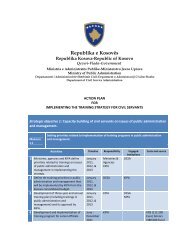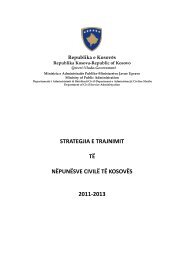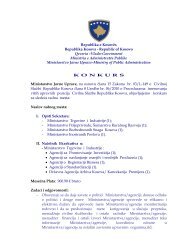Download
Download
Download
Create successful ePaper yourself
Turn your PDF publications into a flip-book with our unique Google optimized e-Paper software.
Improving the health status analysis and demand analysis to help forecast the demand for<br />
services<br />
Defining the basic health package at an affordable level and in a way that can be contracted<br />
for. Align entitlements to services to this package<br />
Improving health information on provider activity/services<br />
Specifying services into purchase units that can be used in service agreements/contracts with<br />
prices based on costs for an efficient provider (there are methods for doing this that permit<br />
gradual increases in sophistication over time starting from a simple approach tailored to the<br />
available information and skills). Costs should cover the full costs of the services otherwise<br />
this creates distortions in behaviours that can lead to inefficiencies.<br />
Designing contracts and contracting approaches to create good incentives for performance<br />
and mitigate risks such as cost shifting, cream skimming, and driving down quality to increase<br />
profits. This includes using incentive based contracting approaches and using competition<br />
where feasible. Contracting strategies have to be carefully designed as only a portion of<br />
elective services can be removed from a hospital before making its services expensive due to<br />
problems in managing the relationship between acute/elective services. Clinical viability also<br />
has to be considered. The government has to manage its ownership interests in public<br />
hospitals by not unnecessarily undermining their ability to be clinically and financially viable<br />
while also taking advantage of the gains from competition.<br />
Monitoring many aspects of performance including performance on service contracts and<br />
acting on performance issues.<br />
Encouraging improvements in the provider market. This will include changing the<br />
configuration of government owned providers to lift efficiency and effectiveness; making<br />
improvements in governance and accountability arrangements for government service<br />
providers; and market development including encouraging the development of an effective<br />
private sector<br />
The view has been expressed that contracts or service agreements are not required in the health<br />
sector with publicly owned providers, but this overlooks the considerable gains that these agreements<br />
can deliver through clarifying performance expectations linked to funding, setting out service volume<br />
and quality requirements, and creating incentives for performance through their design and<br />
application. They can be a critical part of improving information and incentives. They are also going<br />
to be essential as tools to manage the various flows of funding and performance expectations related<br />
to each of those flows, if the insurance model is implemented and if public health providers supply<br />
services to fee paying patients and groups. Service agreements are also a critical tool for the Minister<br />
of Health and MOH to ensure that providers are being required to deliver appropriate services,<br />
allowing the Minister and MOH to use these agreements (and the annual plan with the statement of<br />
service performance) and formal performance reports as strategic management tools.<br />
The MOH could make progress in all these areas which could bring improvements to the health<br />
services whether or not the system evolved into a model with a central Health Insurance Fund. The<br />
MOH can have the role of contracting for the basic health package that can be financed from the<br />
government budget, through contracting with a mix of government and private providers, using the<br />
health budget provided by the government. It can develop many of the capabilities required for a<br />
health insurer noted above, but tailored to its role as a government funder/purchaser of health<br />
services rather than a full blown health insurer processing claims and managing revenues from a<br />
variety of sources.<br />
The changes recommended in this review for the MOH structure could be implemented to strengthen<br />
the overall capability of the MOH. This would increase its ability to perform the functions set out<br />
above. The Health Sector Strategy and the operational plan, MTEF and budget bid could all be<br />
adjusted to accommodate the development of the work set out above. There will be consequences<br />
29
















